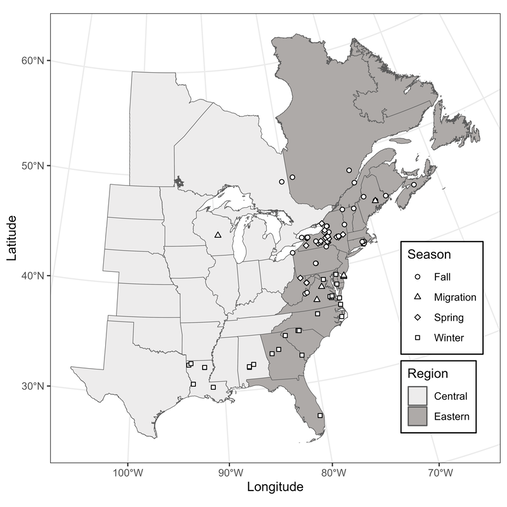Research
Our project seeks to better understand American woodcock migration throughout eastern North America. It began with our pilot season in 2017 when we marked 6 woodcock with satellite transmitters in Maine prior to fall migration. These tags weigh between 4 and 7 grams and periodically send us data on each woodcock's location and status (live or dead) as it moves around the landscape.
Beginning in the fall of 2018, we worked with project partners across the eastern United States and Canada to mark birds with satellite transmitters throughout their breeding and wintering range (see figures below). This allows us to monitor woodcock during both spring and fall migration. Check out our migration page for the current status of our marked birds, and our explore data page for previous seasons' data.
Beginning in the fall of 2018, we worked with project partners across the eastern United States and Canada to mark birds with satellite transmitters throughout their breeding and wintering range (see figures below). This allows us to monitor woodcock during both spring and fall migration. Check out our migration page for the current status of our marked birds, and our explore data page for previous seasons' data.
|
Thus far, questions we are using this data to examine include:
This data has recently made its way into national products, specifically the American Woodcock page of Audubon's Bird Migration Explorer, which allows users to contrast individual bird movement and abundance data with connectivity and conservation threat data. Many thanks to all of our collaborators for making this possible! As of the end of Fall 2022, we have deployed transmitters on 568 woodcock, which have gathered more than 32,000 locations. Annual project progress reports are available for download below. Also, see this Story Map from the Wildlife and Sport Fish Restoration Program, which highlights the history of woodcock research in North America, including the most recent advances through the EWMRC! |

Capture sites are distributed throughout the Eastern Management Region (dark grey), with a few capture sites in the Central Management Region (light gray). Capture efforts are primarily focused prior to fall and spring migration, however some woodcock are captured during fall migration. Last updated December 2023.
|
|
|
| ||||||||||||||||||
|
| |||||||||||||
Copyright © 2024 Eastern Woodcock Migration Research Cooperative.
All Rights Reserved.
All Rights Reserved.
